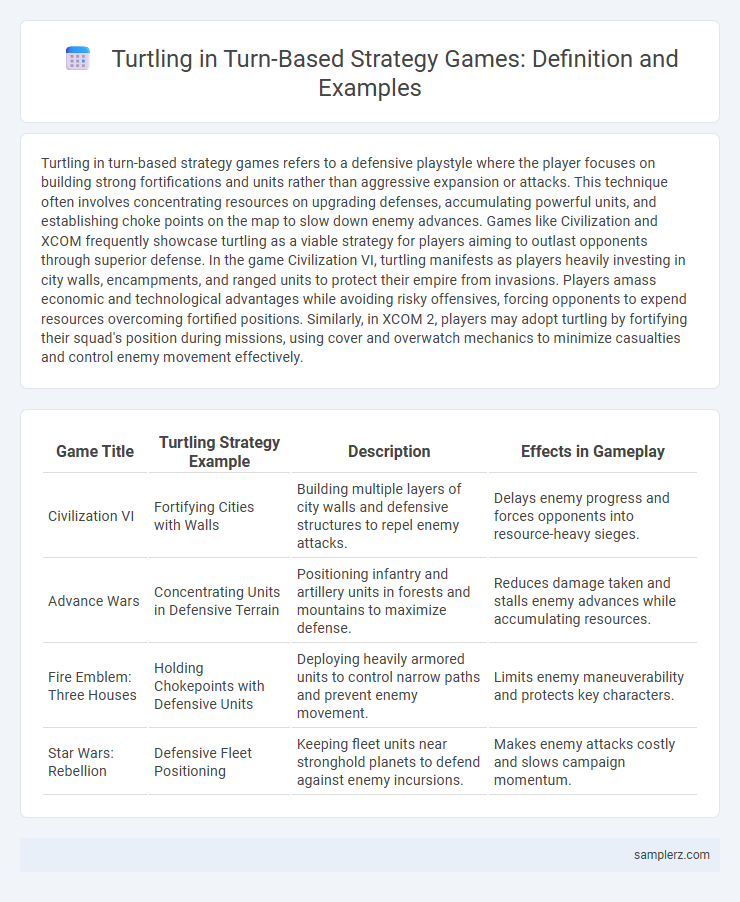Turtling in turn-based strategy games refers to a defensive playstyle where the player focuses on building strong fortifications and units rather than aggressive expansion or attacks. This technique often involves concentrating resources on upgrading defenses, accumulating powerful units, and establishing choke points on the map to slow down enemy advances. Games like Civilization and XCOM frequently showcase turtling as a viable strategy for players aiming to outlast opponents through superior defense. In the game Civilization VI, turtling manifests as players heavily investing in city walls, encampments, and ranged units to protect their empire from invasions. Players amass economic and technological advantages while avoiding risky offensives, forcing opponents to expend resources overcoming fortified positions. Similarly, in XCOM 2, players may adopt turtling by fortifying their squad's position during missions, using cover and overwatch mechanics to minimize casualties and control enemy movement effectively.
Table of Comparison
| Game Title | Turtling Strategy Example | Description | Effects in Gameplay |
|---|---|---|---|
| Civilization VI | Fortifying Cities with Walls | Building multiple layers of city walls and defensive structures to repel enemy attacks. | Delays enemy progress and forces opponents into resource-heavy sieges. |
| Advance Wars | Concentrating Units in Defensive Terrain | Positioning infantry and artillery units in forests and mountains to maximize defense. | Reduces damage taken and stalls enemy advances while accumulating resources. |
| Fire Emblem: Three Houses | Holding Chokepoints with Defensive Units | Deploying heavily armored units to control narrow paths and prevent enemy movement. | Limits enemy maneuverability and protects key characters. |
| Star Wars: Rebellion | Defensive Fleet Positioning | Keeping fleet units near stronghold planets to defend against enemy incursions. | Makes enemy attacks costly and slows campaign momentum. |
Understanding Turtling in Turn-Based Strategy Games
Turtling in turn-based strategy games refers to a defensive playstyle where players prioritize fortifying their positions and accumulating resources rather than engaging in aggressive expansion or attacks. This strategy often involves building strong defensive units and structures to withstand enemy offensives while preparing for a decisive counterattack. Mastering turtling can lead to victory by outlasting opponents and exploiting weaknesses once their aggression diminishes.
Classic Turtling Example: Civilization Series
In the Civilization series, classic turtling involves players focusing on building strong defenses and economic infrastructure while avoiding early aggression, allowing them to outlast opponents in prolonged games. This strategy emphasizes constructing walls, fortifying cities, and investing in technology advancements to gain a late-game advantage. By securing resources and maintaining a defensive posture, players can transition into a powerful military or cultural victory once their opponents have expended their resources.
Turtling in XCOM: Defensive Base Operations
Turtling in XCOM involves fortifying defensive base operations by maximizing cover utilization and strategically positioning soldiers to withstand enemy assaults. Players prioritize reinforcing walls, deploying overwatch abilities, and conserving resources to maintain prolonged defensive stances. This approach reduces exposure to enemy fire, enabling tactical counterattacks in turn-based combat scenarios.
Heroes of Might and Magic: Fortifying Towns
In Heroes of Might and Magic, turtling involves fortifying towns by upgrading walls, building defensive structures, and amassing powerful garrisons to repel enemy forces effectively. Players focus on maximizing town defenses with improvements like the town hall, fortifications, and arcane vault, which enhance resilience and resource generation during sieges. This strategy provides a stronghold for prolonged defense, allowing heroes to accumulate resources and units while delaying aggressive engagements in turn-based combat.
Advance Wars: Bunkering Down Tactics
In Advance Wars, turtling involves aggressively fortifying units within bunkers to maximize defense and minimize damage from enemy attacks. This strategy leverages terrain advantages and unit positioning to create strongholds that slow enemy advances and force opponents into unfavorable engagements. Effective turtling can control key map areas while conserving resources for counterattacks in later turns.
Total War Series: Building Defensive Empires
In the Total War series, turtling manifests through heavily fortified settlements and stacked defensive units, prioritizing resource management and attrition warfare to outlast opponents. Players often fortify key cities with walls, garrisons, and reinforcements, creating nearly impregnable defensive empires that stall enemy advances. This strategy leverages terrain advantages and combined arms defense, forcing adversaries into costly, prolonged engagements.
Fire Emblem: Holding Strategic Choke Points
In Fire Emblem, turtling is exemplified by strategically holding choke points to control enemy movement and minimize exposure to attacks. Players position defensive units in narrow corridors or doorways, leveraging terrain advantages and high-defense characters to stall enemy advances effectively. This tactic maximizes survivability and allows for careful counterattacks in turn-based combat.
Endless Legend: Defensive City Development
In Endless Legend, turtling manifests through defensive city development by prioritizing fortress upgrades, walls, and outposts to maximize protection against enemy invasions. Players invest in advanced defensive technologies and terrain exploitation, slowing opponent progress and strengthening resource accumulation within fortified borders. This strategy enables sustainable growth and strategic flexibility in late-game scenarios of turn-based strategy matches.
Panzer General: Defensive Grid Maneuvers
In Panzer General, turtling is exemplified by establishing a defensive grid where units form overlapping zones of control, minimizing exposure and maximizing terrain advantages such as forests and hills. Players concentrate forces in fortified positions, leveraging unit synergy and supply lines to absorb enemy offensives while preparing counterattacks. This methodical approach extends unit longevity, controls the battlefield tempo, and exploits the game's hex-based system for strategic depth.
Age of Wonders: Utilizing Defensive Spells and Units
In Age of Wonders, turtling is effectively executed by focusing on defensive spells such as Shield and Fortify, which enhance unit durability and create stronghold positions. Utilizing units like the heavily armored Dwarven Infantry or Wizard Towers further consolidates defenses, making frontline breaches difficult for opponents. This strategy leverages terrain advantages and spell synergy to maximize survival and resource accumulation during prolonged matches.

example of turtling in turn-based strategy Infographic
 samplerz.com
samplerz.com